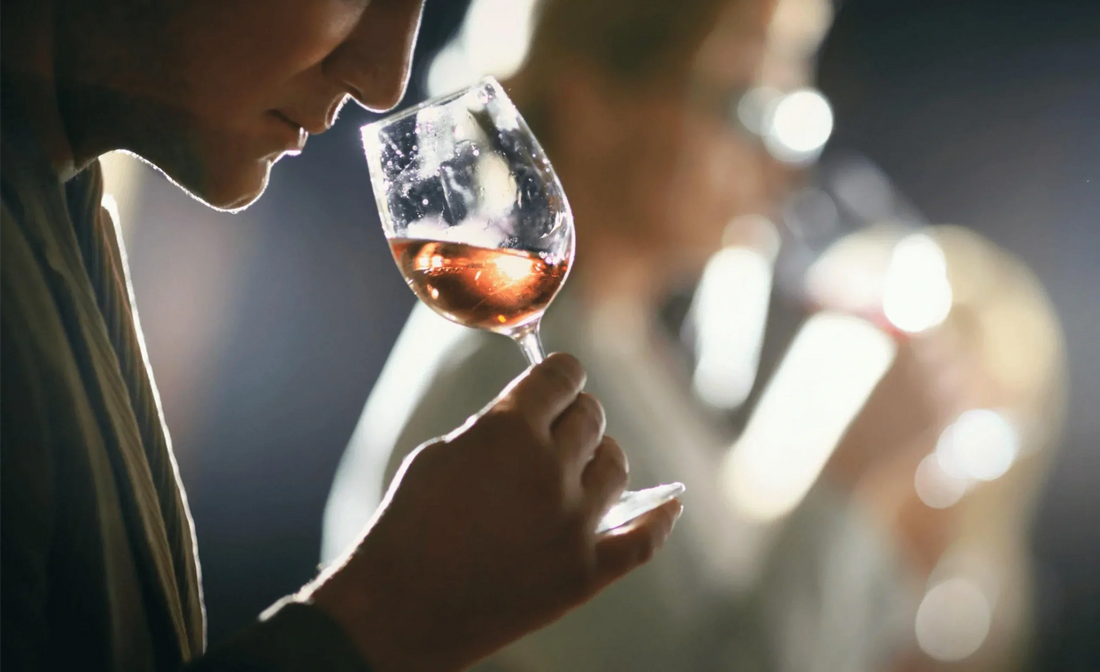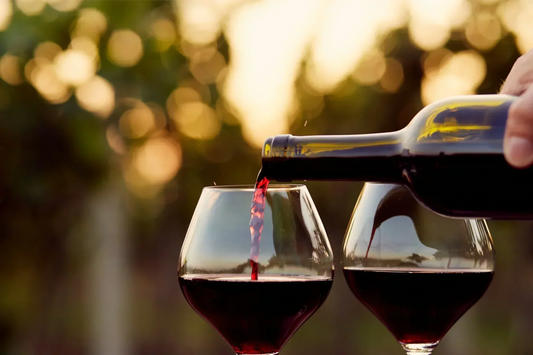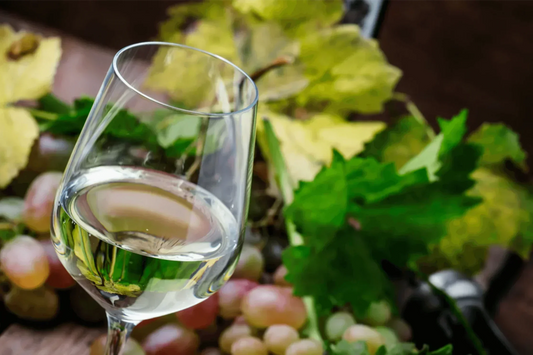
How to Taste Wine: A Simple, Step-by-Step Guide for Beginners
Learning how to taste wine is simpler than you might think, and anyone can do it. It’s more than just swirling and sipping; it’s about exploring flavours, aromas, and textures while appreciating the craft behind each bottle. In this guide, you’ll find straightforward, expert-backed tips for wine tasting that will help you enjoy every glass with confidence
Quick Guide: 5 Essential Steps on How to Taste Wine Like a Pro
Before we explore the detailed techniques, here’s a quick overview of the five key wine tasting steps. Use this table as your essential checklist, then scroll down for expert tips, common mistakes to avoid, and examples that will boost your wine tasting skills.
| Five Key Wine Tasting Steps | |||
|---|---|---|---|
| Step | What to Do | Why It Matters | Pro Tip to Try |
| 1. See | Examine the wine’s colour, clarity, and rim variation. | Reveals clues about the wine’s age, grape variety, and style. | Hold your glass at a 45° angle against a white background for better visibility. |
| 2. Swirl | Gently rotate the glass to aerate the wine. | Releases aromatic compounds, making the wine’s bouquet more expressive. | Swirl from the base of the stem to avoid spilling and over‑agitation. |
| 3. Smell | Take short, deliberate sniffs to identify aromas. | Builds your aroma memory and helps detect wine faults. | Try naming at least three scents—from fruits to herbs—before taking a sip. |
| 4. Sip | Take a small sip and roll it across your tongue. | Evaluates flavour balance, body, acidity, and tannins. | Let the wine coat your mouth before swallowing to capture all taste sensations. |
| 5. Savour | Focus on the length and evolution of flavours after swallowing. | A longer, evolving finish is often a sign of higher quality. | Time the finish in seconds,the longer it lasts, the more memorable the wine. |
Preparing for a Wine Tasting: What You Need Before You Sip
Before you learn how to taste wine like a pro, setting the right environment is key. Proper preparation not only enhances the experience but also ensures you can fully appreciate the wine’s colour, aroma, and flavour. Here’s what you’ll need for the perfect wine tasting setup:
- Choose the right wine glass: Use a clean, clear glass that’s large enough to swirl the wine without spilling. Shape matters less than clarity and cleanliness.
- Use a white background: A white tablecloth or sheet of plain paper helps you accurately judge the wine’s colour and clarity.
- Ensure good lighting: Natural daylight is ideal, but any neutral lighting will work for visually evaluating wine.
- Keep the area scent-free: Avoid strong smells from perfume, candles, or cooking, which can interfere with detecting the wine’s aromas.
- Follow the 20/20 rule: Chill red wine for about 20 minutes before serving, and take white wine out of the fridge approximately 20 minutes prior to tasting for the best flavour.
Once your setting is ready, you’ll be able to focus entirely on each step of wine tasting and get the most from your glass.
Step-by-Step Guide on How to Taste Wine
Wine tasting is all about engaging your senses: sight, smell, and taste. By following this process, you can go beyond casual sipping and truly appreciate the craftsmanship behind each glass. Here’s a simple five-step wine tasting guide, perfect for beginners and enthusiasts alike.
See: Inspect the Wine’s Appearance

The first step in wine tasting begins with your eyes. Examining a wine’s colour, clarity, and intensity can provide valuable insights into its grape variety, age, and style even before you take a sip. Hold your glass at an angle against a white background to see its appearance clearly.
Key things to look for:
- Colour & Hue: Red wines may range from deep purple to brick red, while whites can vary from pale straw to golden amber.
- Intensity: A deeper colour can suggest a fuller-bodied wine, while lighter tones may indicate a more delicate style.
- Clarity: A clear, bright wine often suggests it has been well-made, whereas haze or cloudiness may indicate it’s unfiltered or developing naturally.
- Rim Variation: The colour difference between the centre and edge of the wine can hint at age. Older reds often show orange or brown tints at the rim.
Swirl: Let the Aromas Unfold

Gently swirling your wine in the glass helps release its aromatic compounds, allowing you to experience its bouquet fully. This movement increases the wine’s surface area, allowing oxygen to interact with it and enhance the aromas. Hold the stem or base of your glass, give it a smooth, controlled swirl, and notice how the scents begin to open up, a crucial step in preparing your senses for tasting.
Key swirling tips:
- Use the Table for Stability: Rest the base of your glass on a flat surface and swirl in small circles if you’re new to wine tasting.
- Avoid Over-Swirling: Too much swirling can cause the wine to lose delicate aromas.
- Observe While Swirling: Notice the "legs" or "tears" that form on the glass, as they can hint at the wine’s alcohol content and body.
Smell: Discover Aromatic Layers

A wine’s aroma is one of its most revealing features, providing clues about its grape variety, age, winemaking process, and even its origin. To capture the full aromatic profile, bring the glass to your nose and take short, gentle sniffs instead of one deep inhale. This allows your senses to detect different layers without becoming overwhelmed. You’ll often notice primary aromas from the grapes (fruity, floral, herbal), secondary notes from fermentation (spicy, yeasty), and tertiary scents from ageing (nutty, woody, earthy). Here are common aroma categories in wine; try to identify these flavours during your next tasting.
| A Guide to Common Wine Aromas | ||
|---|---|---|
| Category | Term | How It Smells |
| Fruity | Blackberry, Cherry, Plum | Juicy, ripe, often jammy—like a summer pie or fruit compote. |
| Citrus (Lemon, Grapefruit) | Zesty, bright, slightly tart; imagine the freshness of citrus zest. | |
| Tropical (Pineapple, Mango) | Sweet, exotic, lush—like a fruit salad in the sun. | |
| Floral | Rose, Violet, Jasmine | Delicate, powdery, sometimes perfumed—like fresh‑cut flowers or scented lotion. |
| Herbal / Green | Mint, Basil, Green Pepper | Crisp and leafy; evokes fresh herbs or garden vegetables. |
| Spicy | Clove, Black Pepper, Cinnamon | Warm and pungent—like mulled wine, spice racks, or incense. |
| Woody / Oaky | Vanilla, Toast, Cedar | Smooth, toasty, or slightly smoky—think oak barrels or warm pastry. |
| Earthy / Mineral | Wet Stone, Forest Floor, Mushroom | Damp, grounded, rustic—like rain on pavement or walking in the woods. |
| Nutty / Aged | Hazelnut, Almond, Leather | Deep and mellow; notes that hint at age, cellar, or savoury treats. |
Sip: Evaluate Taste and Texture

This is the moment you’ve been waiting for, the heart of the tasting experience. Take a small sip and let the wine slowly coat your tongue. Hold it in your mouth for a few seconds, allowing air to mingle with the wine to release more flavours. This step is all about recognising the layers of taste and feeling the texture as it moves across your palate.
As you sip, pay attention to:
- Primary flavours: Directly from the grapes, often fruity, floral, or spicy.
- Secondary flavours: Developed during fermentation, creamy, yeasty, or toasty.
- Tertiary flavours: Emerge with ageing, notes of leather, nuts, dried fruit, or complex spice.
Also, notice the balance between sweetness, acidity, tannins, and alcohol. A well-balanced wine feels harmonious, with each element complementing the others.
Savour: Understand the Finish

This is the moment you’ve been waiting for; the finish is where the wine leaves its lasting impression. After swallowing (or spitting at a tasting), focus on how long the flavours linger. This lingering sensation reveals depth, complexity, and quality, often showcasing nuances you didn’t detect earlier.
Ask yourself:
- Does the flavour evolve and surprise you over time?
- Is there a refreshing acidity or smooth warmth that enhances the experience?
- Do new notes appear after the initial sip, adding intrigue?
The finish is like the final chapter of a story. When done well, it leaves you wanting another glass.
Tips for Wine Tasting
- Go slowly and savour the moment: Wine tasting isn’t a race. Follow each step, pause between sips, and enjoy the experience.
- Jot down your impressions: Note aromas, flavours, and the finish. This builds your wine memory and sharpens your palate.
- Track your favourites: Use a wine app or notebook to record bottles you’ve enjoyed. It’s both fun and helpful for future choices.
- Practice with blind tasting: Cover the labels and rely on your senses. It’s a great way to challenge and improve your skills.
- Train your senses daily: Smell and taste everyday items like berries, herbs, and spices so these notes are easier to recognise in wine.
- Trust your instincts: If it smells like cheese, wet stone, or something unexpected, that’s valid! Wine is full of surprises.
- Give it time: If a wine feels "closed," let it breathe. And don’t forget to rest your nose now and then.
Why Canned Wine Is Perfect for Wine Tasting?
Gone are the days when wine tasting meant committing to a full bottle, searching for a corkscrew, or bringing out the decanter. Canned wine makes tasting simple, enjoyable, and accessible, all while providing the same quality and flavour you’d expect from traditional bottles. Perfectly portioned, they’re ideal for tasting flights, casual evenings with friends, or sharpening your palate one sip at a time.
Why canned wine is perfect for wine tasting:
- Try multiple styles in one sitting, no leftovers, no waste.
- Easy to open and pour, anytime, anywhere.
- High-quality wines in portable, eco-friendly packaging.
From crisp whites and refreshing rosés to bold reds and sparkling treats, canned wine allows you to explore a range of styles without waste or fuss, just pure enjoyment in every pour.
Not sure where to start canned wine tasting?
Skip the guesswork! Get curated canned wines delivered, so you can explore new flavours without opening a whole bottle.
Start Your Wine Tasting Journey TodayConclusion
Wine tasting is a journey of curiosity and enjoyment, helping you discover your unique preferences one sip at a time. From sight to finish, each step deepens your appreciation for wine. And with the convenience of canned wine, exploring new styles is easier than ever, no full bottles required. Whether alone or with friends, just pour, swirl, sip, and savour, your next favourite could be in your next can.
FAQ
1. Do I need special equipment for wine tasting?
No, you can start with just a clean wine glass and good lighting. However, using a proper wine glass (tulip-shaped) helps concentrate aromas, and a spittoon is useful if you’re tasting multiple wines.
2. How long should I swirl wine before smelling it?
Usually, 5-10 seconds is sufficient. The aim is to aerate the wine so aromas are released. Swirling for too long may not improve the scent and could cause spillage.
3. Should I taste white wine before red wine?
Yes, when tasting several wines, begin with lighter options (white, sparkling, or rosé) before progressing to fuller-bodied reds. This maintains your palate's freshness and prevents lighter flavours from being overwhelmed.
4. What’s the best way to describe wine aromas and flavours?
Divide them into categories: fruit, floral, herbal, spice, earth, or oak-related. Using a wine aroma wheel or flavour chart can help you develop a richer vocabulary.
5. How do I avoid palate fatigue during wine tasting?
Take small sips, drink water between samples, and use plain crackers to reset your palate. If possible, limit tasting to 5-6 wines in one session.



